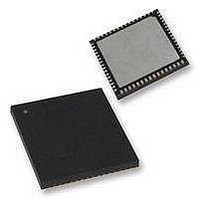PIC18F65K90-I/MR Microchip Technology, PIC18F65K90-I/MR Datasheet - Page 53

PIC18F65K90-I/MR
Manufacturer Part Number
PIC18F65K90-I/MR
Description
32kB Flash, 2kB RAM, 1kB EE, NanoWatt XLP, LCD 64 QFN 9x9x0.9mm TUBE
Manufacturer
Microchip Technology
Series
PIC® XLP™ 18Fr
Datasheet
1.PIC18F65K90-IMR.pdf
(570 pages)
Specifications of PIC18F65K90-I/MR
Processor Series
PIC18F
Core
PIC
Data Bus Width
8 bit
Program Memory Type
Flash
Program Memory Size
32 KB
Data Ram Size
2 KB
Interface Type
I2C, SPI
Maximum Clock Frequency
64 MHz
Number Of Timers
8
Operating Supply Voltage
1.8 V to 5.5 V
Maximum Operating Temperature
+ 125 C
3rd Party Development Tools
52715-96, 52716-328, 52717-734, 52712-325, EWPIC18
Minimum Operating Temperature
- 40 C
On-chip Adc
12 bit, 16 Channel
Core Processor
PIC
Core Size
8-Bit
Speed
64MHz
Connectivity
I²C, LIN, SPI, UART/USART
Peripherals
Brown-out Detect/Reset, LCD, POR, PWM, WDT
Number Of I /o
53
Eeprom Size
1K x 8
Ram Size
2K x 8
Voltage - Supply (vcc/vdd)
1.8 V ~ 5.5 V
Data Converters
A/D 16x12b
Oscillator Type
Internal
Operating Temperature
-40°C ~ 85°C
Package / Case
64-VFQFN Exposed Pad
Lead Free Status / Rohs Status
Details
- Current page: 53 of 570
- Download datasheet (5Mb)
4.0
The PIC18F87K90 family of devices offers a total of
seven operating modes for more efficient power man-
agement. These modes provide a variety of options for
selective power conservation in applications where
resources may be limited (such as battery-powered
devices).
There are three categories of power-managed modes:
• Run modes
• Idle modes
• Sleep mode
There is an Ultra Low-Power Wake-up (ULPWU) for
waking from the Sleep mode.
These categories define which portions of the device
are clocked, and sometimes, at what speed. The Run
and Idle modes may use any of the three available
clock sources (primary, secondary or internal oscillator
block). The Sleep mode does not use a clock source.
The ULPWU mode, on the RA0 pin, enables a slow fall-
ing voltage to generate a wake-up, even from Sleep,
without excess current consumption. (See
“Ultra Low-Power
The power-managed modes include several power-
saving features offered on previous PIC
is the clock switching feature, offered in other PIC18
devices. This feature allows the controller to use the
SOSC oscillator instead of the primary one. Another
power-saving feature is Sleep mode, offered by all PIC
devices, where all device clocks are stopped.
4.1
Selecting a power-managed mode requires two
decisions:
• Will the CPU be clocked or not
• What will be the clock source
TABLE 4-1:
2009-2011 Microchip Technology Inc.
Sleep
PRI_RUN
SEC_RUN
RC_RUN
PRI_IDLE
SEC_IDLE
RC_IDLE
Note 1:
Mode
2:
POWER-MANAGED MODES
Selecting Power-Managed Modes
IDLEN reflects its value when the SLEEP instruction is executed.
Includes INTOSC (HF-INTOSC and MG-INTOSC) and INTOSC postscaler, as well as the LF-INTISC source.
IDLEN<7>
POWER-MANAGED MODES
N/A
N/A
N/A
Wake-up”.)
0
1
1
1
OSCCON Bits
(1)
SCS<1:0>
N/A
00
01
1x
00
01
1x
®
devices. One
Section 4.7
Clocked
Clocked
Clocked
CPU
Module Clocking
Off
Off
Off
Off
Peripherals
Clocked
Clocked
Clocked
Clocked
Clocked
Clocked
PIC18F87K90 FAMILY
Off
The IDLEN bit (OSCCON<7>) controls CPU clocking,
while the SCS<1:0> bits (OSCCON<1:0>) select the
clock source. The individual modes, bit settings, clock
sources and affected modules are summarized in
Table
4.1.1
The SCS<1:0> bits select one of three clock sources
for power-managed modes. Those sources are:
• The primary clock, as defined by the OSC<3:0>
• The secondary clock (the SOSC oscillator)
• The internal oscillator block (for LF-INTOSC
4.1.2
Switching from one power-managed mode to another
begins by loading the OSCCON register. The
SCS<1:0> bits select the clock source and determine
which Run or Idle mode is used. Changing these bits
causes an immediate switch to the new clock source,
assuming that it is running. The switch may also be
subject to clock transition delays. These considerations
are discussed in
and Status Indicators”
Entering the power-managed Idle or Sleep modes is
triggered by the execution of a SLEEP instruction. The
actual mode that results depends on the status of the
IDLEN bit.
Depending on the current and impending mode, a
change to a power-managed mode does not always
require setting all of the previously discussed bits. Many
transitions can be done by changing the oscillator select
bits, or changing the IDLEN bit, prior to issuing a SLEEP
instruction. If the IDLEN bit is already configured as
desired, it may only be necessary to perform a SLEEP
instruction to switch to the desired mode.
Configuration bits
modes)
4-1.
None – All clocks are disabled
Primary – XT, LP, HS, EC, RC and PLL modes.
This is the normal, Full-Power Execution mode.
Secondary – SOSC Oscillator
Internal oscillator block
Primary – LP, XT, HS, RC, EC
Secondary – SOSC oscillator
Internal oscillator block
Available Clock and Oscillator Source
CLOCK SOURCES
ENTERING POWER-MANAGED
MODES
Section 4.1.3 “Clock Transitions
and subsequent sections.
(2)
(2)
DS39957D-page 53
Related parts for PIC18F65K90-I/MR
Image
Part Number
Description
Manufacturer
Datasheet
Request
R

Part Number:
Description:
Manufacturer:
Microchip Technology Inc.
Datasheet:

Part Number:
Description:
Manufacturer:
Microchip Technology Inc.
Datasheet:

Part Number:
Description:
Manufacturer:
Microchip Technology Inc.
Datasheet:

Part Number:
Description:
Manufacturer:
Microchip Technology Inc.
Datasheet:

Part Number:
Description:
Manufacturer:
Microchip Technology Inc.
Datasheet:

Part Number:
Description:
Manufacturer:
Microchip Technology Inc.
Datasheet:

Part Number:
Description:
Manufacturer:
Microchip Technology Inc.
Datasheet:

Part Number:
Description:
Manufacturer:
Microchip Technology Inc.
Datasheet:










